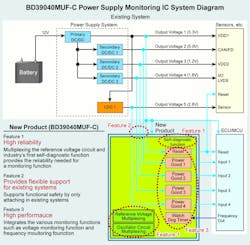Power-Monitoring IC Has Built-In Self-Diagnostic Function
ROHM recently announced the availability of a power-supply monitoring integrated circuit (IC), the BD39040MUF-C, with built-in self-test (BIST) that supports functional safety. The IC is well-suited for automotive application power-supply systems requiring fail-safe measures such as electric power steering as well as sensors and cameras for autonomous driving and advanced driver-assistance systems (ADAS), says the company.
Rapid advances in ADAS and automated driving in the automotive sector have spurred demand for functions such as collision prevention and lane assist that reduce the risk of accidents. Accordingly, product development for mounted semiconductors has to take into account how to ensure functional safety (fail-safe) in the event of failure, considering self-diagnostic and other functions.
In 2017, ROHM developed an LCD chipset which supported functional safety and consisted of LCD drivers and power-supply ICs ahead of the industry. In 2018, the company acquired certification of the development process under the international functional safety development standard ISO26262. At this time, when considering the safety and redundancy of systems, incorporating various self-test and monitoring functions, ROHM created the industry’s first power-supply monitoring IC with built-in self-diagnostic function that makes it easy to add functional safety to existing systems.
The BD39040MUF-C is a power-monitoring IC that provides monitoring functions required for functional safety in the power-supply systems of ADAS sensor modules. In addition to voltage-monitoring functions (power good, reset) and a watchdog timer (WDT) for monitoring the ECU essential for functional safety, the power-supply monitoring IC is the first in the industry to introduce a self-diagnostic function, according to ROHM. Using original technology, this IC makes it possible to detect potential failure of the power-supply IC itself without affecting existing systems. The integration of these functions into a compact 3-mm-square package suits it for ADAS applications demanding high miniaturization, claims the company.
Availability: Now (samples), August 2019 (OEM quantities)
Key Features
Self-diagnostic function provides the reliability needed for functional safety
For functional safety, to clear the highest safety requirement level (ASIL) it is necessary to detect potential failures of the power-supply monitoring function itself. For example, in case a failure occurs when a monitoring function (that is, overvoltage) cannot detect an abnormality, it becomes a hidden fault that masks the breakdown, creating a dangerous situation. To overcome this, the BD39040MUF-C with self-diagnostic function uses original circuit technology that enables it to detect potential failures beforehand. Both the reference voltage and oscillator circuits are multiplexed to enable continuous mutual monitoring between systems in order to improve safety during normal operation.
Provides flexible support for existing systems
The BD39040MUF-C supports functional safety in existing systems without any changes of power-supply sequences. Additionally, the WDT for ECU can be adjusted via external resistance and the effective monitoring timing arbitrarily set on/off. Furthermore, the IC comes in a compact 3-mm-square package ideal for ADAS applications requiring smaller form factor. This addresses the need for more compact, safe driving support modules in ADAS and automated driving systems that demand functional safety.
Integrates various monitoring functions required by automotive power supplies and ECUs
The BD39040MUF-C incorporates a range of monitoring functions, including overvoltage and undervoltage monitoring (power good) required for power supplies, and WDT and reset functions demanded by ECUs. Among these, the WDT is a window-type that monitors whether the ECU is stuck in a loop within a programmable timeout period.
Applications
- Radars, cameras, and sensors for ADAS/automated driving
- ECUs
- Electric power steering
- Dashboard cluster, LCD panels
- Infotainment-Lamps
- Other power systems requiring functional safety measures beyond ASIL-B
Product Overview
- Input voltage range: 2.7 V to 5.5 V
- Self-diagnostic function
- Reset function (overvoltage/undervoltage monitoring)
- 4CH voltage-monitoring function (overvoltage/undervoltage)
- Reference voltage self-monitoring function
- Oscillation frequency self-monitoring function
- Window-type WDT (monitoring time can be set via external resistor; effective WDT timing can be turned on/off)
- Enables air/ground fault detection of the WDT input signal using the WDOUT pin
- AEC-Q100 (Grade 1) qualified


